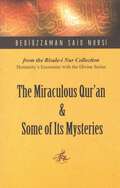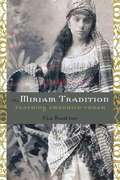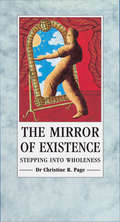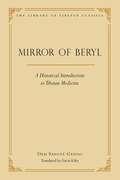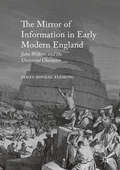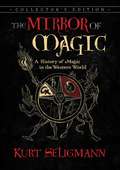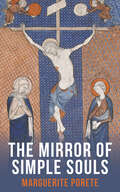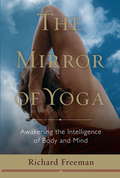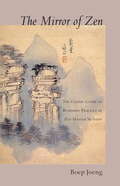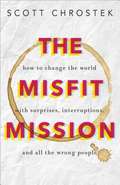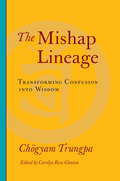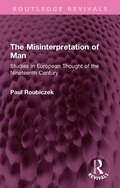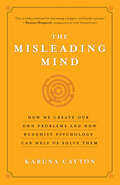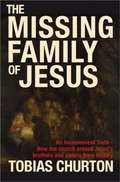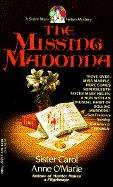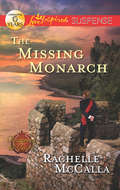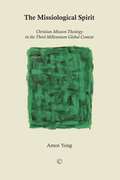- Table View
- List View
The Miraculous Quran and Some of its Mysteries
by Bediuzzaman Said NursiThis book presents a brief comparison between the Qur'an's sacred wisdom and human philosophy, a concise summary of the Qur'anic instruction and training for humanity's personal and social life.
The Miriam Tradition: Teaching Embodied Torah
by Cia SautterThe Miriam Tradition works from the premise that religious values form in and through movement, with ritual and dance developing patterns for enacting those values. Cia Sautter considers the case of Sephardic Jewish women who, following in the tradition of Miriam the prophet, performed dance and music for Jewish celebrations and special occasions. She uses rabbinic and feminist understandings of the Torah to argue that these women, called tanyaderas, "taught" Jewish values by leading appropriate behavior for major life events. Sautter considers the religious values that are in music and dance performed by tanyaderas and examines them in conjunction with written and visual records and evidence from dance and music traditions. Explaining the symbolic gestures and motions encoded in dances, Sautter shows how rituals display deeply held values that are best expressed through the body. The book argues that the activities of women in other religions might also be examined for their embodiment and display of important values, bringing forgotten groups of women back into the historical record as important community leaders
The Mirror Of Existence: Stepping into Wholeness
by Dr Christine PageDr Christine Page invites us to embark on a journey of self-discovery by stepping into the 'Mirror of Existence' where we will find that our own thought processes direct our outer experiences.She inspires us to 'tune in' on the higher frequencies of intuition and inspiration so that our creative impulses have maximum benefit for all concerned.Her thought provoking writing and illustrations help us to recognize reflections of ourselves which, until now, were masked; including the beautiful spiritual being who waits within and whom we have so much difficulty acknowledging.Her book, as a mirror, guides us towards wholeness. All we need are the eyes to see and willingness to enter the experience.
The Mirror of Beryl: A Historical Introduction to Tibetan Medicine (Library of Tibetan Classics #28)
by Gavin Kilty Sangye Desi GyatsoComposed while its author was the ruler of Tibet, Mirror of Beryl is a detailed account of the origins and history of medicine in Tibet through the end of the seventeenth century. Its author, Desi Sangye Gyatso (1653 - 1705), was the heart disciple and political successor of the Great Fifth Dalai Lama and the author of several highly regarded works on Tibetan medicine, including his Blue Beryl, a commentary on the foundational text of Tibetan medicine, The Four Tantras. In the present historical introduction, Sangye Gyatso traces the sources of influence on Tibetan medicine to classical India, China, Central Asia, and beyond, providing life stories, extensive references to earlier Tibetan works on medicine, and fascinating details about the Tibetan approach to healing. He also provides a commentary on the pratimoksha, bodhisattva, and tantric Buddhist vows. Desi Sangye Gyatso's Mirror of Beryl remains today an essential resource for students of medical science in Tibet.
The Mirror of Information in Early Modern England
by James Dougal FlemingThis book examines the seventeenth-century project for a "real" or "universal" character: a scientific and objective code. Focusing on the Essay towards a real character, and a philosophical language (1668) of the polymath John Wilkins, Fleming provides a detailed explanation of how a real character actually was supposed to work. He argues that the period movement should not be understood as a curious episode in the history of language, but as an illuminating avatar of information technology. A non-oral code, supposedly amounting to a script of things, the character was to support scientific discourse through a universal database, in alignment with cosmic truths. In all these ways, J. D. Fleming argues, the world of the character bears phenomenological comparison to the world of modern digital information--what has been called the infosphere.
The Mirror of Magic: A History of Magic in the Western World
by Kurt SeligmannA collector’s edition of the classic, illustrated, and comprehensive history of magic and the occult • Written by renowned Surrealist and magic scholar Kurt Seligmann (1900-1962) • Includes all 250 illustrations from the original 1948 edition • Explores magical practices and beliefs from their origins in the ancient world through the heyday of secret societies in the 18th century In the occult classic The Mirror of Magic, renowned Surrealist Kurt Seligmann (1900-1962) draws from his encyclopedic practitioner’s knowledge and extensive antiquarian collection to offer a comprehensive, illustrated history of magic and the occult from Mesopotamia and ancient Egypt through the 18th century. He explores the gods and divinatory arts of the legendary Sumerians and the star-wise Babylonians, including the birth of astrology. He examines the afterlife beliefs of the ancient Egyptians and the dream interpretation practices and oracles of ancient Greece, including the mysteries of Eleusis and the magical philosophy of Plato, Socrates, and other Greeks. He uncovers the origins of Gnosticism and the suppression and banishment of magic by the post-pagan, Christian emperors of Rome. Seligmann reviews the principles of alchemy, sharing famous transmutations and allegorical illustrations of the alchemical process and explores the Hermetica and its remarkable adepts. Investigating the Middle Ages, the author discusses the work of European magicians of the time, including Albertus Magnus, Roger Bacon, Agrippa, Nostradamus, and Pico Della Mirandola. He studies the medieval practices of devil worship, witchcraft, and black magic, as well as the “Cabala” in both its Hebrew and Christian forms. He also examines the art of the Tarot and many lesser known divination techniques. He explores the development of secret societies, including Freemasonry and Rosicrucianism, in the 17th century and the increase in occult publications and magical science in the 18th century. First published in 1948, this history of magic and the occult seeks to “mirror” the magical worldview throughout the ages. Beautifully illustrated with images from the author’s rare library, this collector’s edition features all of the artwork--more than 250 images--from the original 1948 edition.
The Mirror of N'de: A Novel
by L. K. MaloneIn the mythical city of N'de lives thirteen-year-old Hadlay and her people, the Ramash. Scorned and abused by the unloving and absent Emperor, the Ramash are poor people, placed second to the ruling class of the Oresed. Young but bold, Hadlay rages against the injustice in her city. When she is chosen for the honor of serving the Prince in the Tower, she hopes to find a way to right the wrong . . . but soon discovers that things are worse than she believed.
The Mirror of Simple Souls
by Marguerite PoreteDive into the profound depths of Christian spiritualism with The Mirror of Simple Souls, an early 14th-century work by Marguerite Porete. It's exploration of Oneness with God, though influential at the time of its writing, was denounced by Church authorities as heretical and banned for its supposed connection to Antinomianism. Since it's attribution to Porete in the 1940's, The Mirror of Simple Souls has come to be regarded as among the most important works of medieval Christian mysticism.
The Mirror of Yoga: Awakening the Intelligence of Body and Mind
by Richard FreemanThe world of yoga is astonishingly rich in its array of schools and practices. Yet, as diverse as they seem, they share a common aim: the discovery of the essence of existence that can be found at the core of our being, and the liberation that comes from that discovery. With this worthy goal in mind, Richard Freeman presents an enlightening overview of the many teachings, practices, and scriptures that serve as the basis for all the schools of yoga--hatha, bhakti, jnana, karma, tantra, and others. He shows how the myriad forms are ultimately related, and can even be perceived to make up a vast, interpenetrating matrix, symbolizing the unity, profundity, and beauty of the ancient tradition. Richard's wide-ranging discussion includes the Upanisads and Samkhya philosophies, the Yoga Sutra of Patanjali, the eight limbs of astanga yoga, the process and purpose of hatha yoga, and much more. He also explores the role of the guru, chanting, meditation, and the yogic imperative of offering service to others. All of this is applied to the actual practice, giving the reader the tools to digest and apply the wealth of information to daily life. The Mirror of Yoga will be a welcome resource to all yogis who wish to better practice the profound philosophy underlying their practice.
The Mirror of Zen: The Classic Guide to Buddhist Practice by Zen Master So Sahn
by Boep JoengThe sacred radiance of our original nature never darkens.It has shined forth since beginningless time.Do you wish to enter the gate that leads to this?Simply do not give rise to conceptual thinking. Zen Master So Sahn (1520-1604) is a towering figure in the history of Korean Zen. In this treasure-text, he presents in simple yet beautiful language the core principles and teachings of Zen. Each section opens with a quotation--drawn from classical scriptures, teachings, and anecdotes--followed by the author's commentary and verse. Originally written in Chinese, the text was translated into Korean in the mid-twentieth century by the celebrated Korean monk Boep Joeng. An American Zen monk, Hyon Gak, has translated it into English.
The Mirror of the Blessed Life of Jesus Christ: A Reading Text (Routledge Revivals)
by Nicholas LovePublished in 2005: At a time when the church sought to control and constrain lay access to vernacular and paramystical texts, the author’s translation, sanctioned by the Archbishop of Canterbury, met a pressing need for religious guidance among lay people. It became one of the most copied works of the fifteenth century.
The Miseducation of Cameron Post
by Emily M. Danforth<P>When Cameron Post's parents die suddenly in a car crash, her shocking first thought is relief. Relief they'll never know that, hours earlier, she had been kissing a girl. <P>But that relief doesn't last, and Cam is soon forced to move in with her conservative aunt Ruth and her well-intentioned but hopelessly old-fashioned grandmother. She knows that from this point on, her life will forever be different. Survival in Miles City, Montana, means blending in and leaving well enough alone (as her grandmother might say), and Cam becomes an expert at both. <P>Then Coley Taylor moves to town. Beautiful, pickup-driving Coley is a perfect cowgirl with the perfect boyfriend to match. She and Cam forge an unexpected and intense friendship-one that seems to leave room for something more to emerge. But just as that starts to seem like a real possibility, ultrareligious Aunt Ruth takes drastic action to "fix" her niece, bringing Cam face-to-face with the cost of denying her true self-even if she's not exactly sure who that is. <P>The Miseducation of Cameron Post is a stunning and unforgettable literary debut about discovering who you are and finding the courage to live life according to your own rules.
The Misfit Mission: How to Change the World with Surprises, Interruptions, and All the Wrong People
by Scott ChrostekMany church leaders and other people of faith feel constrained bytime-worn strategies, tactics, and attitudes. Unwritten rules of how todo church seem to force us into neat and tidy patterns. But new ideasand methods are bubbling up in all corners of the Church, and newleaders are taking risks, creating opportunities, and rewriting theircommunities’ definition of church. One such leader is author ScottChrostek. In The Misfit Mission, Chrostek describes what itlooks like for us to do the right thing in ministry, even when logic or‘rules’ say it’s the wrong thing. He shows how we really can do morethan we might ask or imagine, when we remember God’s call and thepromises of scripture—when we live each day with the expectation of holysurprise. Chrostek shares inspiring stories from all sorts ofpeople, and often funny, poignant tales from his ministry as churchplanter and campus pastor of The Church of the Resurrection Downtown, inurban Kansas City. He illustrates how people can uncover their innatepassion for knowing and serving Christ, and how a church can become anintegral part of the community. The misfit mission is God’s owncreative, surprising, crazy-beautiful way, and this book proves how wecan be a part of it!
The Mishap Lineage: Transforming Confusion into Wisdom
by Chogyam TrungpaAll of us experience obstacles as part of our journey, in life and on the spiritual path. In many cases, we think of them as purely something unpleasant to overcome, or as a mistake that needs correcting. Here, Chögyam Trungpa takes a radically different approach to such obstacles, teaching that unexpected chaos, confusion, and emotional upheavals can actually be used as fuel for the journey--an energy that can transform confusion into sanity and wisdom. He illustrates this transformative principle through telling the lively history of the Trungpa tulkus (a lineage within the Kagyü tradition of Tibetan Buddhism), of which he was the eleventh incarnation. Trungpa referred to his lineage as the "Mishap Lineage" because of the ups and downs and colorful lives that were typical of his predecessors, and true of his own life as well. The stories of the Trungpas are seen as a guide for the practitioner's journey and help us to understand how important lineage and community remain for us today.
The Mishap Lineage: Transforming Confusion into Wisdom
by Chogyam TrungpaAll of us experience obstacles as part of our journey, in life and on the spiritual path. In many cases, we think of them as purely something unpleasant to overcome, or as a mistake that needs correcting. Here, Chögyam Trungpa takes a radically different approach to such obstacles, teaching that unexpected chaos, confusion, and emotional upheavals can actually be used as fuel for the journey--an energy that can transform confusion into sanity and wisdom. He illustrates this transformative principle through telling the lively history of the Trungpa tulkus (a lineage within the Kagyü tradition of Tibetan Buddhism), of which he was the eleventh incarnation. Trungpa referred to his lineage as the "Mishap Lineage" because of the ups and downs and colorful lives that were typical of his predecessors, and true of his own life as well. The stories of the Trungpas are seen as a guide for the practitioner's journey and help us to understand how important lineage and community remain for us today.
The Misinterpretation of Man: Studies in European Thought of the Nineteenth Century (Routledge Revivals)
by Paul RoubiczekFirst published in 1949, The Misinterpretation of Man traces the deeper roots of the ideas which found their most striking and disastrous expression in German National Socialism. It attempts to show the wrong turn which European thought took during the nineteenth century and to challenge its dangerous inheritance, so as to make room for the growth of different and better ideals. The author believes that Christian tradition and values are losing their hold over a great majority of nations leading to an erosion of magnanimity and forgiveness. This book will be of interest to students of philosophy and history.
The Misleading Mind: How We Create Our Own Problems and How Buddhist Psychology Can Help Us Solve Them
by Karuna CaytonBuddhism asserts that we each have the potential to free ourselves from the prison of our problems. As practiced for more than twenty-six hundred years, the process involves working with, rather than against, our depression, anxiety, and compulsions. We do this by recognizing the habitual ways our minds perceive and react — the way they mislead. The lively exercises and inspiring real-world examples Cayton provides can help you transform intractable problems and neutralize suffering by cultivating a radically liberating self-understanding.
The Missing (Season of Grace #2)
by Beverly LewisWHILE A FAMILY WAITS, THE TRUTH BECKONS. . . I stumbled upon my mother's handkerchief in the cornfield early this morning. Halfway down the row I spotted it--white but soiled, cast in the mire of recent rains. Only one side of the stitched hem was visible, the letter L poking out from the furrow as if to get my attention. I stared at it . . . all the emotions of the past three weeks threatening to rise up and choke me right then and there. Twice now, I'd walked the field where "A PAINFUL ABSENCE, A DESPERATE HEART... IS IT TOO LATE TO FIND LETTIE BYLER! GRACE BYLER LONGS TO UNCOVER the secret that drove her mother to leave the family weeks ago. When all hopes are dashed for such a search, an unlikely friendship leads to a surprising invitation. Meanwhile, the young Amishman Grace thought was courting her best friend takes a sudden interest in her, and Grace's decision to remain single is challenged even as her determination to find her mother grows." At the same time, Heather, an Englisher, continues with the diagnosis of cancer. How will she deal with it and what is her connection to the Amish community?
The Missing Family of Jesus
by Tobias ChurtonOffering up equal parts controversy and thrills, theological scholar Tobias Churton rips apart the mythology surrounding the family of Jesus to reveal a stunning truth. Using a broad range of sources such as the early Gospels and the Dead Sea Scrolls, Churton lays out his case that St. James the Just was in fact Jesus's brother. Not just a dry reading of the Biblical texts, this journey stretches across continents and reads like a pure thriller as it challenges many assertions made by the Catholic Church.
The Missing Gospels: Unearthing the Truth Behind Alternative Christianities
by Darrell BockWhat others are saying about The Missing Gospels "Darrell Bock has written a timely and valuable study for anyone curious about the question of lost or missing gospels. The Missing Gospels is a breath of sanity!"-Philip Jenkins, Professor of History and Religious Studies, Penn State "Those who don't want their prejudices disturbed will want to avoid this book. Those with an open mind and readiness to learn from scholarship . . . read with profit."-Larry Hurtado, Professor of New Testament Language, Literature, and Theology, University of Edinburgh, Scotland "Darrell Bock patiently, and accessibly, sifts through all the relevant issues and offers much-needed guidance to those who want to discern fact from fiction. If you read only one book on this issue, this is it!"-Andreas J. Kostenberger, PhD, Professor of New Testament and Greek, Southeastern Baptist Theological Seminary "The Missing Gospels is a unique resource for those who wish to respond to the 'new school' with accuracy and confidence."-Frederica Mathewes-Green, National Public Radio's Morning Edition Commentator "A necessary book that corrects many still fashionable but even more questionable hypotheses about the origin of the Gospels, the Nag Hammadi texts, and the development of Christian theology in the first two centuries AD."-Prof. Dr. Martin Hengel, Professor Emeritus of New Testament and Ancient Judaism, University of Tübingen, Germany______________________________For a brief overview from Dr. Bock on the contents of the Gospel of Judas along with other materials, please visit www.thomasnelson.com/missinggospels.
The Missing Ingredient (Mystery and the Minister's Wife #10)
by Diane NobleCopper Mill is in for big excitement, big personalities and one big mystery. Kate loves to cook, but She's mostly excited about the chance to reunite with childhood friend Susannah Applebaum, now the host of her own cooking show. The two catch up and reminisce, but when the network's unpopular producer disappears, all the clues point to the star. Susannah pleads innocence, but how well does Kate really know her friend after all this time? And what is so special about the secret recipes Susannah has been hiding? Meanwhile, suspicious sightings in the unused wing of the Hamilton Springs Hotel lead to speculation of other worldly occurrences, and Paul must offer his congregation frank words of wisdom and a hefty dose of faith. With so much on the line, can Kate find the missing ingredient before it's too late?
The Missing Madonna (Sister Mary Helen Mysteries)
by Carol Anne O'MarieSister Mary Helen is sinfully good at snooping through the San Francisco fog. Now a fellow OWL (Older Woman's League) member has disappeared. The police believe Erma Duran simply flew the coop, but Sister feels a Higher Authority pushing her to investigate. A gold medal entangled in Erma's bedsprings and a cryptic clue to a Byzantine madonna deepens the mystery. By the time Police Inspector Kate Murphy joins the hunt, Sister's good intentions have already paved her way straight to the Mission District--and a hellish encounter with sudden death.
The Missing Madonna: A Sister Mary Helen Mystery (Sister Mary Helen Mysteries #3)
by Carol Anne O'MarieWhen the OWLS, including Sisters Mary Helen and Eileen, return from their convention, their friend Erma Duran goes missing. Did she move away without letting anyone know, as suggested by her friend, landlord and boss, Al Finn? Or has something more sinister happened? And where do her children fit into it?
The Missing Monarch
by Rachelle MccallaSix years ago Crown Prince Thaddeus abandoned his new bride and went into hiding. His motive was to protect his country and his family from a ruthless tyrant. But when his estranged wife tracks him down, Thaddeus knows it's time to make a stand. Restore the royal line. And reclaim the crown. Yet just as he learns about the family's new addition-his and Monica's son-little Peter becomes a target. In a deadly game of power, Thaddeus must choose between the country and heritage he's been raised to defend...and the woman he never could forget.
The Missiological Spirit: Christian Mission Theology in the Third Millennium Global Context
by Amos YongThe field of the theology of mission has developed variously across Christian traditions in the last century. Pentecostal scholars and missiologists also have made their share of contributions to this area. This book brings the insights of pentecostal theologian Amos Yong to the discussion. It delineates the major features of what will be argued as central to a viable vision and praxis for Christian mission in a postmodern, post-Christendom, post-Enlightenment, post-Western, and postcolonial world. What emerges will be a distinctively pentecostally- and evangelically-informed missiological theology, one rooted in the Christian salvation-history narrative of Incarnation and Pentecost that is yet open to the world in its many and various cultural, ethnic, religious, and disciplinary discourses and realities. The argument unfolds through dialogical engagements with the work of others, concrete case studies, and systematic theological reflection. Yong's pneumatological and missiological imagination proffers a model for Christian theology of mission suitable for the twenty-first-century global and pluralistic context even as it exemplifies how a missiological understanding of theology itself unfolds amidst engagements with contemporary ecclesial practices andacademic/theological impulses.
